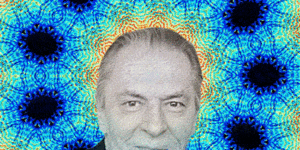The Keys to Living in Infinite Possibility: How to Bend Reality and Do the Impossible
BY MEL SCHWARTZ
 sure, living in infinite possibility sounds good but how do you actually do it? psychologist mel shwarz offers tried and true practices for bending reality based on deep psychology and quantum physics research. photo: alessio lin
sure, living in infinite possibility sounds good but how do you actually do it? psychologist mel shwarz offers tried and true practices for bending reality based on deep psychology and quantum physics research. photo: alessio lin
Our sense of self is constructed early in life, sometimes through traumatic events and at other times more subtly. An aspect of quantum physics called wave collapse can illuminate how this construction occurs and, more importantly, how we can empower ourselves to live a life that is unburdened by our past and open to infinite possibility.
Moving From Limited Reality to Infinite Possibilities
One day in my office, a client named Jill recalled the words her mother spoke to her when she was about eight years old: “When I learned I was pregnant with you, I told your father I didn’t want another baby.” Despite the fact that her mother was otherwise devoted and loving, Jill’s acutely personal takeaway was damning. She felt unwanted and therefore unlovable, then and ever since. She carried this core belief with her throughout her life, limiting her potential for infinite possibilities. Her own inner monologue was perpetually self-critical, confirming her belief that she wasn’t lovable. The snapshot Jill had taken of herself early in her life had become etched into her psyche as her embedded truth.
Jill’s belief affected her relations with her husband, children, and friends. Notwithstanding her husband Bob’s loving devotion to her, Jill questioned his loyalty and truthfulness in light of seeing herself as unlovable. Her belief about herself was becoming a self-fulfilling prophecy: she was forcing Bob to withdraw his love as his frustration mounted. What Jill experienced is not uncommon, for what we believe to be true about ourselves—and others—contributes to our reality-making process and whether we experience a reality of infinite possibility or not. Prior to her mother’s remark, Jill’s identity could have evolved in limitless ways, but that range of possibility became narrowed by that one short sentence.
The Quantum Worldview
For virtually all of us whose beliefs have been ingrained with the mechanistic worldview, the world as seen through quantum physics appears to be suffused with a kind of non-rational strangeness. One of the fundamental aspects of the quantum worldview, for instance, is that elementary particles exhibit a somewhat “schizophrenic” nature. I use that word not in its complex clinical sense but in the conventional meaning of having a “split personality”—and every quantum entity indeed has the dual capacity to exist as either a wave or a particle.
Physicists refer to this tendency as wave-particle duality—a notion that rubs against our commonsense logic. Ordinarily, we believe that things either are or are not, that they are distinct in their nature. This either-or thinking can also be referred to as binary thinking, which leaves only two distinct paths open to us. Binary thinking, the opposite of infinite possibilities, is a major aspect of how we observe and construct reality. Yet this either-or reality apparently doesn’t apply in the quantum realm and is questionable in our everyday lives as well.
The quantum reality exists in what is known as a series of probability waves, with an infinite possibility of potential outcomes. This means that when the particle is not being observed, it exists as a waveform, which in quantum language represents a state of pure potential, known as superposition. This term proposes that as long as we do not know what the state of any object is, it actually exists in all possible states simultaneously, as long as we don’t look to check. In that sense, the wave represents pure possibility. The very act of observation reduces the wave (potential) to a fixed thing—a particle. This reduction is referred to as wave collapse.All that may sound far removed from our day-to-day world of personal relationships, fears and anxieties, love and hate. Yet a similar thing occurs in our lives. When we have particular experiences and make certain observations of ourselves, or have them made of us—typically in childhood—we experience the psychological equivalent of a quantum wave collapse.
Our Roots in Pure Potential
As newborns or infants, if not at conception and in utero, we resemble the infinite possibilities of the wave; our personality, not yet defined, is in a state of potential. Notwithstanding matters of genetics, environmental influences, or considerations of archetypal, astrological, or karmic influences (however we may feel about those concepts), our identity is not yet determined and fixed. But before long, we move from the potential of the wave to the “thingness” of the particle. The personal evolution of our personality gets stunted, and our growth becomes fitful. How does this happen?
Ordinarily, even a single yet significant experience is sufficient to collapse our personal wave of potential. Jill experienced a powerful wave collapse after her mother spoke one particular sentence to her. Sometimes all it takes is a hurtful statement or an embarrassing experience in our early years to reduce the potential of our personality to a narrow, restricted self-image. These events need not be traumatic; they may, in fact, be subtle. Yet in those moments, our potential fades. It’s as if we have taken a snapshot of ourselves, and we become frozen in time. I refer to these as confining wave collapses, in contrast to the defining wave collapses that usher in defining moments of infinite possibility. We are no longer the potential of the wave but the finiteness of the particle. And we carry this picture of ourselves with us through our lives, allowing it to burden and limit us. We lose the authorship of our life story.
Beliefs: Gates to Infinity or Walls of a Jail Cell
The initial wave collapse sets up a recurring incidence of similar experiences as our beliefs about ourselves and others become self-reinforcing. What we think of ourselves shapes our interactions with both others and ourselves. This habit obstructs our ability to change or evolve as we cling to our perceived “truth” of who we are.
The themes of subsequent collapses may vary, but they are often self-limiting if not denigrating. We generate thoughts such as “I’m not good enough” or “I’m not smart enough,” or even more simply, “I’m not loveable.” The actors who perhaps unwittingly participate in scripting our personal beliefs are often our parents, but they may also be teachers, friends, relatives, or even strangers. We cling to these habituated beliefs about ourselves in accordance with our primary wave collapses. In spite of new events that should cause us to reconsider or reevaluate our beliefs—for example, Bob’s devotion to and love for Jill—we remain rooted in the way we see ourselves. We become embedded in the groove of our self-referencing beliefs and block the opportunity for growth, change and infinite possibility.Less dramatically than the hurtful comments or abusive actions of others, the patterns of family dynamics may cause us to acquire certain personality traits. These influences tend to be more chronic and may fly beneath our radar screen. If you grew up in a highly conflicted or alcoholic family, for instance, you may have coped by developing a people-pleaser or peacemaker persona. We can think of this chronic condition as an extended wave collapse rather than the result of the acute single event.
I had referred another client, Helen, to meet a colleague of mine so that they might explore matters of mutual professional interest. Helen made an appointment to meet with Jim at a conference he would be attending. When Helen arrived, Jim was engaged in conversation with others and didn’t notice her waiting to introduce herself. Shortly thereafter, Jim left the conference without acknowledging Helen.
“I guess I just wasn’t important enough for him to wait to meet me,” Helen said to me later. She reported this as though it were an established fact instead of an interpretive opinion of her own constructing. I asked her how she knew this to be true and whether other explanations might apply. For example, I knew Jim to be notoriously absentminded; he might simply have forgotten he was supposed to meet her at the conference, or he may not have noticed her waiting to introduce herself. In fact, he had overlooked appointments with me in the past, and I certainly didn’t conclude that he viewed me as unimportant.
I suggested that Helen saw herself as not valuable, and she was projecting that insult onto Jim, thinking he saw her as she saw herself. At first she resisted this possibility. She related some compelling stories, which revealed that as a child she had felt like her mother’s servant and that her entire childhood was about her dutiful obedience to her mother. Helen waited on her mother hand and foot, as their parent-child roles were reversed. She was deprived of the value that every child deserves, and so she basically felt unimportant. This wave collapse had disastrous effects on her self-esteem. Throughout her life, her thoughts almost automatically continued to affirm this affliction, shutting down her potential for infinite possibilities.
Our primary beliefs about ourselves that have been generated by our wave collapses orchestrate the quality and nature of our thoughts, which make specific the general theme of the wave collapse. If, like Helen, our core belief is that we are not of value, we can predict the kinds of thoughts we might then experience, such as “I’m not important” or “Why should he pay attention to me? I don’t matter.” These thoughts measure ourselves against others, and the predictable result is that we see ourselves as subordinate to others. These thoughts and their resulting feelings can leave us trapped inside a self-induced container of low self-esteem.
Returning to Pure Potential
To free yourself from repeating harmful and confining wave collapses, consider this Possibility Principle: In the nanosecond before your next thought, you are in a state of pure potential.
In the space between our thoughts, we are similar to the wave—full of infinite possibilities. Once we attach to our next thought, the ensuing wave collapses, and we create our reality in that moment. If we continue to have self-limiting or injurious thoughts, we remain adhered to the damaging effects of the primary wave collapse. In therapy, a client often experiences a breakthrough, a significant moment during which a highly anticipated insight becomes illuminated. This event presents a new state of potential and, with it, the possibility of a defining moment, in which the client can break into new terrain. The person will then select which reality to summon by thinking either “What a relief! I’ve broken through” or “What’s wrong with me? Why has this taken so long?” One thought is self-affirming and offers relief and the possibility of vaulting forward, while the other is self-critical and resists progress. The thought you select will chart your path.
How Our Thoughts Affect Our Reality
Simply put, the thought we engage will summon the reality of our next moment and will determine whether we experience a reality of infinite possibility or not. We can move forward in breaking new ground, or we can summon an old familiar thought, abandoning the insight. Obviously, we can choose vastly differing experiences. The potential is all that exists prior to the next thought. Our struggle with change is in part caused by our habituation to old thoughts.
Helen’s confining wave collapse of feeling devalued set in motion her lifelong inner narrative. I could see the automatic nature of her thought coming through in the statement, “I guess I’m not important enough for him to wait for me.” This type of thought, instinctive and programmed, burdened and afflicted Helen. I worked with her to identify that thought and separate from it so that she could see what it was telling her. This established another essential principle for her: if you can learn to see the thought, you don’t have to become the thought.
As we talked further, I asked Helen whether she had attempted to contact Jim after the conference. She continued to cling to her story that there wasn’t any point in doing so because she had been blown off. I suggested that her thought had indeed told her that she was blown off, but how could she actually know that for a fact? What she was doing was creating a storyline to conform to her beliefs and her personal history. Was she perhaps simply replicating wave collapses from earlier in her life? Was this her thought stuck in an old groove? When pressed, she couldn’t offer proof that her story was true. If we can’t know for sure that our story is true, then we need to look at how we confuse our story with the truth of a given situation. I asked Helen if it was plausible that she had believed an untruth about herself her entire life. She reconsidered and acknowledged that she might be personalizing the events around her meeting with Jim to conform to her self-image.
When I explained to Helen the theory behind wave collapse, she quickly grasped the concept. I had her envision an alternative and positive wave collapse in which her mother had been maternally inclined and actually doted on her. What then might her belief about herself be? She permitted herself this alternative point of view and considered that perhaps she wasn’t irrelevant. Doing so meant that she also needed to embrace her discomfort as she moved beyond the limits of her familiar zone. (As much as we may suffer with our limiting beliefs, we often feel dissonance between our old beliefs and new ones and apprehension about stepping into the new potential and infinite possibility of who we may become when we release the old beliefs.) Our work then focused on helping Helen break free from her addictive tendency to malign herself—or more precisely, the tendency of her thought.
Helen’s progress from that point was impressive. She began to value herself, and this shift in her self-esteem led to her experiencing her relationships in an entirely new way. By severing the grip of her old identity, she gave herself the opportunity to select a new and positive wave collapse with self-affirming thoughts. Breaking free from the predictability of the confining wave collapse requires uprooting the repetitive thoughts that inform the old belief. Noticing the repetition of these old thoughts, in lockstep with the wave collapse, enables the shift.
The Infinite Potential of the Superposition
The quantum view of the universe tells us that reality appears to unfold perpetually from a state of potential—what we earlier called superposition. To access the universal potential, we must devote ourselves to apprehending that infinite possibility, which lies in the instant prior to collapsing the wave with our next thought or feeling. Our thought literally summons our construed reality. Thoughts that emanate from the habitual groove of old wave collapses are likely to re-create more of the same feelings and experiences. Our thoughts therefore re-present our past experience. This is why we struggle with change. Taking a new snapshot and actualizing new thinking will, however, script a new experience, allowing us to participate fully in an evolving reality.
Exercise: Releasing Your Past and Programming Yourself for an Infinite Future
Appreciating how the wave collapses in our lives informed our sense of self is essential in priming the pump for change. Often the meanings we attribute to the events of our personal history prevent us from creating effective change, as we are reduced to seeing ourselves as victims. Many adults have memories of an abusive, loveless, or disappointing childhood because they didn’t receive the nurturing and love that is every child’s birthright. But if we choose to keep focusing on limiting events of our past, then we choose a present that predicts a similar future. At some point, we need to stop choosing to believe the meaning we ascribed to our past and script a different present that opens us up to infinite possibilities.
I am not suggesting that we either avoid or suppress painful memories. By all means, we need to bring them into the light and process them, so we can loosen their grip on us. The goal, though, is to disarm them and eventually release them. The thought that we choose in the present moment is almost entirely responsible for who we are in that moment. If we continue to summon the same habitual thoughts, we won’t realize the infinite possibilities and potential that await us.
What we are seeking are new wave collapses that implant positive self-reflections and identities as we grow past the grip of the negative ones. These new defining wave collapses offer the route for our defining moments.
In working with Jill, I asked her to consider what she could have said when her mother told her that she hadn’t wanted another baby when she found out she was pregnant with Jill. Jill responded, “That makes me feel terrible and unwanted.” Had she actually said that at the time, she might have experienced a positive defining wave collapse. Simply reliving that encounter in a way that gave her some power was part of her healing process. By expressing her feelings, she was able to establish a worthier sense of self. Instead of thinking, “I am unlovable,” which speaks to a fixed state of being, she could reframe her belief to “I’ve thought of myself as unlovable, and now I know why.” This belief is amenable to change.
Think of a core belief you hold about yourself that greatly limits how you experience your life. We think of these beliefs as our “truth.” They may range from “I’m not smart enough” to “People just don’t respect me.” Or they may sound like “I’m a poor communicator” or “Conflict makes me uncomfortable, so I avoid confrontation.”
1. After you’ve identified that core belief, ask yourself how you came to this belief. You might recall an embarrassing, shameful, or traumatic moment from earlier in life in which this “truth” took hold. For example, you raised your hand in class to ask a question, and everyone laughed at how silly your question seemed. So you decided to never risk that kind of exposure again. Now you play it safe and really think long and hard before you speak. Or your belief could have been caused by more chronic circumstances, like growing up in a volatile home and coming to believe that you couldn’t really share how you felt out of fear of catalyzing violence.
2. This is the confining wave collapse that has created your limiting belief about yourself. If it was caused by a specific moment in which you felt shamed or ridiculed, picture yourself back in that moment. Then imagine yourself finding your voice. Tell those involved how you feel about what just happened or what they said or did to you. Finding your voice in this way helps release you from the bondage of the confining wave collapse. Reflect on how different your beliefs about yourself would be if this event had never happened.
3. If your beliefs about yourself were informed by chronic rather than acute circumstances, such as having an alcoholic or abusive parent or growing up in a volatile home, remind yourself that these beliefs are a product of your experience. Imagine yourself being raised in a loving and supportive family. Now how differently might you feel about yourself? Once you choose to reclaim your potential, you cease being a victim of damaging circumstances. Say to yourself, “I don’t need to be imprisoned by my past if I choose to free myself from my limiting beliefs.”
You are more than your experiences, and an infinite potential of possibility awaits you as you allow your identity to evolve. Once you learn to see how your beliefs are informing you, you are free to break into new terrain and achieve a defining moment. Witness your thoughts and recognize the story they are telling you. Don’t confuse them with the truth. You can learn to rewrite your story.
Many individuals were fortunate enough to have experienced exemplary defining wave collapses that affirmed them and helped them to secure a strong sense of self. This typically leads to healthy self-esteem that enables them to craft their personalities and experiences free from constrictive encumbrances. But those of us who haven’t yet experienced such a gift can learn how to overcome our burdens and reach the full range of our possibilities. The way we’ve been trained to think that change is hard or implausible once again grows out of our operating worldview. This belief in inertia developed from the causal determinism of the mechanistic worldview in which our present and future are dependent on our past. The new principle derived from the participatory worldview—potentiality—invites us to free ourselves from aspects of our past that don’t serve us. We needn’t stay stuck in the fixed state of the particle but can ride the infinite possibilities of the wave.
This piece on living in infinite possibility is excerpted with permission from The Possibility Principle: How Quantum Physics Can Improve the Way You Think, Live, and Love
by Mel Schwartz.
About The Author
Mel Schwartz practices psychotherapy in Westport, Connecticut and New York City in addition to working with individuals globally. He is one of the first practicing psychotherapists to integrate the principles of quantum physics into an approach for living an empowered life. He earned his graduate degree from Columbia University and is the author of The Possibility Principle and The Art of Intimacy, The Pleasure of Passion. Visit his website: melschwartz.com






















